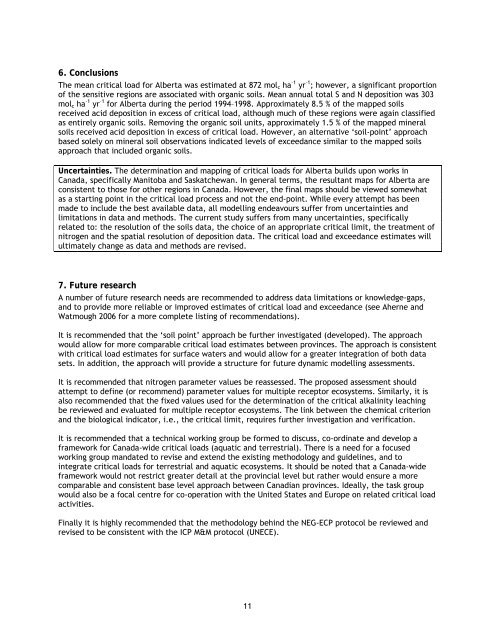calculating critical loads of acid deposition for forest soils in ... - CCME
calculating critical loads of acid deposition for forest soils in ... - CCME
calculating critical loads of acid deposition for forest soils in ... - CCME
Create successful ePaper yourself
Turn your PDF publications into a flip-book with our unique Google optimized e-Paper software.
6. Conclusions<br />
The mean <strong>critical</strong> load <strong>for</strong> Alberta was estimated at 872 mol c ha –1 yr –1 ; however, a significant proportion<br />
<strong>of</strong> the sensitive regions are associated with organic <strong>soils</strong>. Mean annual total S and N <strong>deposition</strong> was 303<br />
mol c ha –1 yr –1 <strong>for</strong> Alberta dur<strong>in</strong>g the period 1994–1998. Approximately 8.5 % <strong>of</strong> the mapped <strong>soils</strong><br />
received <strong>acid</strong> <strong>deposition</strong> <strong>in</strong> excess <strong>of</strong> <strong>critical</strong> load, although much <strong>of</strong> these regions were aga<strong>in</strong> classified<br />
as entirely organic <strong>soils</strong>. Remov<strong>in</strong>g the organic soil units, approximately 1.5 % <strong>of</strong> the mapped m<strong>in</strong>eral<br />
<strong>soils</strong> received <strong>acid</strong> <strong>deposition</strong> <strong>in</strong> excess <strong>of</strong> <strong>critical</strong> load. However, an alternative ‘soil-po<strong>in</strong>t’ approach<br />
based solely on m<strong>in</strong>eral soil observations <strong>in</strong>dicated levels <strong>of</strong> exceedance similar to the mapped <strong>soils</strong><br />
approach that <strong>in</strong>cluded organic <strong>soils</strong>.<br />
Uncerta<strong>in</strong>ties. The determ<strong>in</strong>ation and mapp<strong>in</strong>g <strong>of</strong> <strong>critical</strong> <strong>loads</strong> <strong>for</strong> Alberta builds upon works <strong>in</strong><br />
Canada, specifically Manitoba and Saskatchewan. In general terms, the resultant maps <strong>for</strong> Alberta are<br />
consistent to those <strong>for</strong> other regions <strong>in</strong> Canada. However, the f<strong>in</strong>al maps should be viewed somewhat<br />
as a start<strong>in</strong>g po<strong>in</strong>t <strong>in</strong> the <strong>critical</strong> load process and not the end-po<strong>in</strong>t. While every attempt has been<br />
made to <strong>in</strong>clude the best available data, all modell<strong>in</strong>g endeavours suffer from uncerta<strong>in</strong>ties and<br />
limitations <strong>in</strong> data and methods. The current study suffers from many uncerta<strong>in</strong>ties, specifically<br />
related to: the resolution <strong>of</strong> the <strong>soils</strong> data, the choice <strong>of</strong> an appropriate <strong>critical</strong> limit, the treatment <strong>of</strong><br />
nitrogen and the spatial resolution <strong>of</strong> <strong>deposition</strong> data. The <strong>critical</strong> load and exceedance estimates will<br />
ultimately change as data and methods are revised.<br />
7. Future research<br />
A number <strong>of</strong> future research needs are recommended to address data limitations or knowledge-gaps,<br />
and to provide more reliable or improved estimates <strong>of</strong> <strong>critical</strong> load and exceedance (see Aherne and<br />
Watmough 2006 <strong>for</strong> a more complete list<strong>in</strong>g <strong>of</strong> recommendations).<br />
It is recommended that the ‘soil po<strong>in</strong>t’ approach be further <strong>in</strong>vestigated (developed). The approach<br />
would allow <strong>for</strong> more comparable <strong>critical</strong> load estimates between prov<strong>in</strong>ces. The approach is consistent<br />
with <strong>critical</strong> load estimates <strong>for</strong> surface waters and would allow <strong>for</strong> a greater <strong>in</strong>tegration <strong>of</strong> both data<br />
sets. In addition, the approach will provide a structure <strong>for</strong> future dynamic modell<strong>in</strong>g assessments.<br />
It is recommended that nitrogen parameter values be reassessed. The proposed assessment should<br />
attempt to def<strong>in</strong>e (or recommend) parameter values <strong>for</strong> multiple receptor ecosystems. Similarly, it is<br />
also recommended that the fixed values used <strong>for</strong> the determ<strong>in</strong>ation <strong>of</strong> the <strong>critical</strong> alkal<strong>in</strong>ity leach<strong>in</strong>g<br />
be reviewed and evaluated <strong>for</strong> multiple receptor ecosystems. The l<strong>in</strong>k between the chemical criterion<br />
and the biological <strong>in</strong>dicator, i.e., the <strong>critical</strong> limit, requires further <strong>in</strong>vestigation and verification.<br />
It is recommended that a technical work<strong>in</strong>g group be <strong>for</strong>med to discuss, co-ord<strong>in</strong>ate and develop a<br />
framework <strong>for</strong> Canada-wide <strong>critical</strong> <strong>loads</strong> (aquatic and terrestrial). There is a need <strong>for</strong> a focused<br />
work<strong>in</strong>g group mandated to revise and extend the exist<strong>in</strong>g methodology and guidel<strong>in</strong>es, and to<br />
<strong>in</strong>tegrate <strong>critical</strong> <strong>loads</strong> <strong>for</strong> terrestrial and aquatic ecosystems. It should be noted that a Canada-wide<br />
framework would not restrict greater detail at the prov<strong>in</strong>cial level but rather would ensure a more<br />
comparable and consistent base level approach between Canadian prov<strong>in</strong>ces. Ideally, the task group<br />
would also be a focal centre <strong>for</strong> co-operation with the United States and Europe on related <strong>critical</strong> load<br />
activities.<br />
F<strong>in</strong>ally it is highly recommended that the methodology beh<strong>in</strong>d the NEG-ECP protocol be reviewed and<br />
revised to be consistent with the ICP M&M protocol (UNECE).<br />
11
















